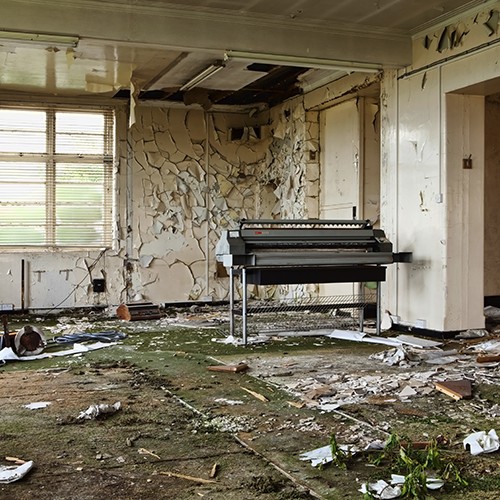In this extensive body of work 'Pallion: Where Ships Were Born' I have explored the location of what was once dubbed 'the largest shipbuilding town in the world', capturing the changing environment of one of the last surviving shipyards in Sunderland; Pallion Engineering. Sunderland has a proud 600 year history of shipbuilding, which in the early 1900's employed 12,000 men; over a third of the town's adult population. Now the workforce is a mere dozen and their future is uncertain. The city, like the shipyard, is changing. Wearside, once an industrial hub is undergoing a transformation, old industries dieing and new businesses sprouting. The region developed as a coal port but it was Sunderland's superior shipbuilding which brought Wearside world recognition. Sunderland has been producing ships since 1346 and has been the birthplace of many famous vessels including 'The Torrens' on which Joseph Conrad sailed and began his first novel whilst aboard. Between 1939 and 1945 the Wear yards launched 245 merchant ships totaling 1.5 million tons, a quarter of the merchant tonnage produced in the UK at this period. Competition from overseas caused a downturn in demand for Sunderland built ships toward the end of the twentieth century.Large ships are no longer built in Sunderland, but part of the industry does still remain; predominantly the refurbishment and demolition of vessels. The yard has been sectioned into smaller units where a variety of work takes place, the core of the work reflects the previous uses of the space; steel being the material which links many of the businesses. However the offices of Pallion Engineering have been long since abandoned leaving behind a Mary Celeste style shrine. The once opulent board room with adjoining dining room and kitchen constructed at the height of Pallion ambition now lay abandoned as moss and ferns cover every surface. This reclamation of nature reflects the nature of the Wearsiders as they reclaim their identities in a shifting world. Growing up in the North-East I feel I bring a fresh yet understanding eye to this project. During my life I have been witness to many changes; I grew up during a time of mass privatization of the Nations industries and have watched societies change, unemployment rise and fall as job roles and identities shift. I hope to have articulated these changes as the search for a new working class identity takes place. Paul Alexander Knox 2007
Paul Alexander Knox
Photographer
Where Ships were Born
Location: Tyne & Wear
Nationality: British
Biography:
 I am a documentary photographer working to examine social and cultural structures both locally and globally. In the North East of England I have focused on industrial history and the changing social structure impacted by the loss of industry, as...
MORE

1 of 44
© 2024 Paul Alexander Knox

2 of 44
© 2024 Paul Alexander Knox

3 of 44
© 2024 Paul Alexander Knox

4 of 44
© 2024 Paul Alexander Knox

5 of 44
© 2024 Paul Alexander Knox

6 of 44
© 2024 Paul Alexander Knox

7 of 44
© 2024 Paul Alexander Knox

8 of 44
© 2024 Paul Alexander Knox

9 of 44
© 2024 Paul Alexander Knox

10 of 44
© 2024 Paul Alexander Knox

11 of 44
© 2024 Paul Alexander Knox

12 of 44
© 2024 Paul Alexander Knox

13 of 44
© 2024 Paul Alexander Knox

14 of 44
© 2024 Paul Alexander Knox

15 of 44
© 2024 Paul Alexander Knox

16 of 44
© 2024 Paul Alexander Knox

17 of 44
© 2024 Paul Alexander Knox

18 of 44
© 2024 Paul Alexander Knox

19 of 44
© 2024 Paul Alexander Knox

20 of 44
© 2024 Paul Alexander Knox

21 of 44
© 2024 Paul Alexander Knox

22 of 44
© 2024 Paul Alexander Knox

23 of 44
© 2024 Paul Alexander Knox

24 of 44
© 2024 Paul Alexander Knox

25 of 44
© 2024 Paul Alexander Knox

26 of 44
© 2024 Paul Alexander Knox

27 of 44
© 2024 Paul Alexander Knox

28 of 44
© 2024 Paul Alexander Knox

29 of 44
© 2024 Paul Alexander Knox

30 of 44
© 2024 Paul Alexander Knox

31 of 44
© 2024 Paul Alexander Knox

32 of 44
© 2024 Paul Alexander Knox

33 of 44
© 2024 Paul Alexander Knox

34 of 44
© 2024 Paul Alexander Knox

35 of 44
© 2024 Paul Alexander Knox

36 of 44
© 2024 Paul Alexander Knox

37 of 44
© 2024 Paul Alexander Knox

38 of 44
© 2024 Paul Alexander Knox

39 of 44
© 2024 Paul Alexander Knox

40 of 44
© 2024 Paul Alexander Knox

41 of 44
© 2024 Paul Alexander Knox

42 of 44
© 2024 Paul Alexander Knox

43 of 44
© 2024 Paul Alexander Knox

44 of 44
© 2024 Paul Alexander Knox
Public Story
Where Ships were Born
